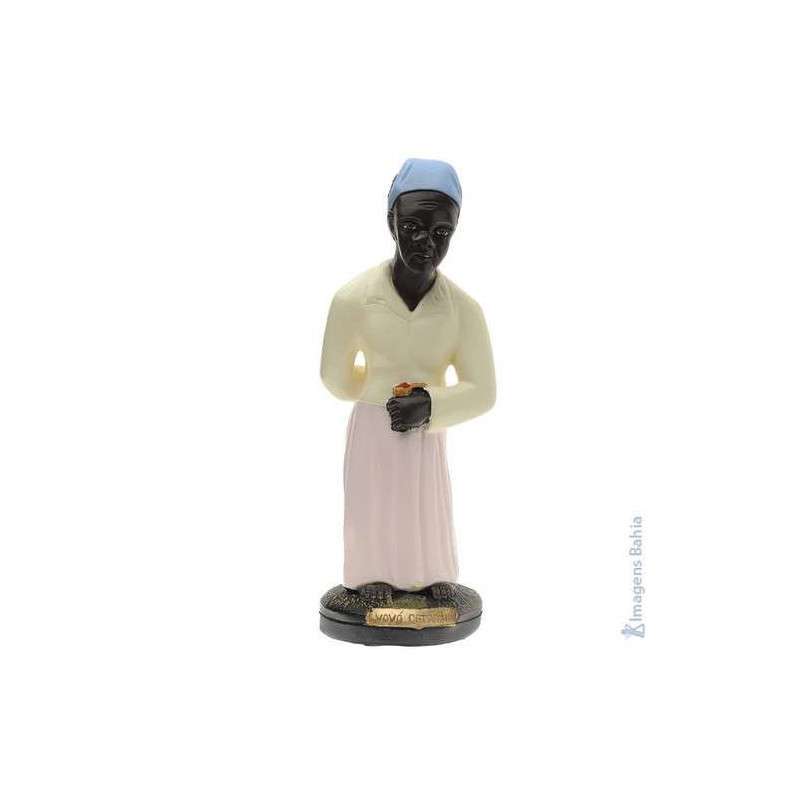



Image of Vovo Catarina
Material: Hand-painted plaster.
Size: Approximately 20 cm tall.

Security policy

Delivery policy
Among so many others, on that slave ship – a harbinger of captivity – coming from Angola, there was a girl: Catarina!
Early torn from its roots and its native soil, it was carried, by the waters and by force, to a destination that was at once unknown and fearful. That girl, far from her ancestors, would complete a long journey that would finally bring her into our society.
And it was there, sitting on a stump, that Grandma Catarina, holding her cane and caressing a rosary, told me her story.
Almost nothing remains of her childhood, at least nothing that she wanted to tell me. Her narrative already finds her an adult, a captive on a farm, in a land called Brazil.
Squeezed among other black women, in a slave quarters, Catarina has an obligation to bring other souls into the world, profit for her master.
Her skillful midwife's hands trimmed those creatures that were born under the insignia of slavery. Slavery of souls, of rights, of roots, of wanting, of everything! Marked all, with the sign of the owner, marked all to just survive. Each child born filled his heart with pain for the destiny that was in store for them.
Her commitment to her master was not just to bring those unfortunate little ones into the world, but strong and capable “pieces” for the job.
If fate missed one, she was severely punished for the damage done. For that, she paid with pain, a punished body, attached to the trunk, for each soul that Zambi carried away.
Every black woman who gave birth reinforced her decision never to give her children to slavery. The herbs she knew helped her in this purpose, making her sterile. She also allowed herself to be “ugly”, in an attempt not to serve her master's reproductive purposes.
She was ugly on the outside, but she kept the inner beauty that had already been born with her, the strength of her ancestors and the depth of her roots, although early plucked, a burning desire for freedom still germinated in her, if not for herself, for those of her family. color.
One day, nature brought the pain of a difficult birth to the big house. Even in a comfortable bed, between clean sheets, the lady's suffering and her master's anguish were equal to those of any black man and ended up bringing Catarina's experience to that room.
Hastily called, as a last resort, she did what no one had the courage to do. His black and sure hands penetrated that white girl's entrails and placed the baby in the proper position to be born.
All the weight of responsibility had turned into relief and joy. She never wanted to lose any soul and that one in particular depended on her life. The black woman, accustomed to flogging, was now gratefully presented. By bringing the little lord into the world, she falls into the graces of the lords, receiving the privilege of no longer being attached to the trunk.
The years go by, Sinhozinho grows up and Catarina grows old. The force that united them, on the day of her birth, makes him her protector, presenting her with a home, outside the slave quarters. There, Catarina experiences the only feeling of freedom she knows: loneliness. The silence and recollection are only broken by the screams: “Catarina, run!”.
The old lady advances through the pastures, running and praying, because she knows that she has a black woman giving birth. Her life is taken like this, with her hands bringing other lives into the world. The woman who was never a mother is now the grandmother of many, which is why she is called Grandma Catarina.
The black girl, smuggled out of her homeland by greed, torn from her roots for the color of her skin, sold like merchandise, flogged by overseers, fulfills her destiny as a midwife. She brings into the world, inside the filthy slave quarters, dozens of children of her color, to share her own suffering, the suffering reserved for those who have no right, not even to their own body.
A single white birth gives her the undeniable right to live far from the trunk. What captivity is this that separates people by skin color?
So many white souls stained with blood. So much white skin tinged with the black of slavery. So many lives tied to the burden of having to pay with reincarnations, each link in the chain that bound a human being to his fellow man.
Grandma Catarina, from the height of her wisdom, says she knows that slavery, as much as it was cruel, was not useless.
She served to redeem the mistakes made by her people, when still incarnated in African lands. “The righteousness of God makes no mistakes.”
Each imprisoned black man was also chained to his own mistakes, rescuing them, one by one, with pain, humiliation and blood.
She says: “There is no people more suffering, even today, than those who have the same color as mine. Every black man and woman who is working in this house today has their own sins to pay, and one day, if necessary, they will return reincarnated to settle their debts”.
Grandma Catarina still shows, in her hands, the marks of the irons that attached her to the trunk. By allowing me to see them – her hands and her scars – she opened my heart and ears to the details of a